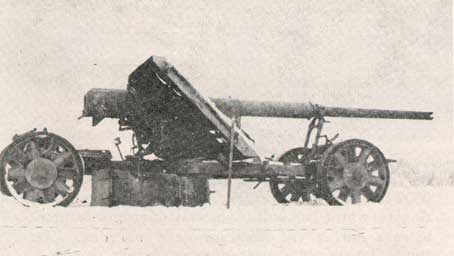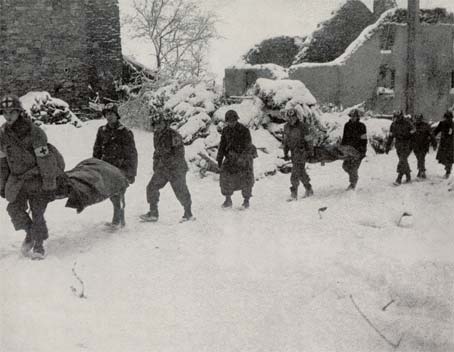| |
To strengthen the American line and to prevent a German
breakthrough, the 35th Division, less the 134th Infantry Regiment
still fighting East of Bastogne, was trucked back to Metz
on January 19th to pick up replacements and re-equip, clean
up, get a good meal and then move on by convoy to defensive
positions in the front line in the Vosge Mountains about 25
miles southeast of Saarguemines, between the 100th and the
45th Divisions. There we awaited a renewal of the German offensive
which quite agreeably with us never came. We engaged in patrol
actions and some artillery dueling which, compared to Bastogne,
was a welcome relief, although the snow and cold persisted.
The newly arrived shoe pacs, designed to cut down on trench
foot, were a welcome addition in the Vosge snow drifts so
long as we could remain in defensive positions.

KO'd Tiger Royal in Belgium
Meanwhile our 134th Regiment East of Bastogne continued pressure
on von Runstedt’s rear guard who mounted delaying actions
to cover the retreating German Armies. The Regiment experienced
heavy artillery fire and some sharp infantry fire fights as
they advanced steadily eastward, skirmishing daily with the
German 560th and 340th Volksgrenadier Divisions, eventually
arriving on January 31st at the Our River and outskirts of
the Siegfried Line. No complaints appeared to be registered
when the 17th Airborne Division relieved our Santa Fe soldiers
on January 31st so that they could rejoin the division now
en route to Holland.
With the removal of the threat of German counter-attack,
the allies could return to the completion of the Rhineland
campaign to sweep the Germans from the West bank of the Rhine
River. The weather, one of the coldest winters in Europe on
record, was moderating. We looked to return to the Third Army,
but surprise! It seems that Ninth Army had some new divisions
that were untested and that a battle trained, tested and proven
division like the 35th – what you might call shock troops
– would be a stabilizing factor to have in Ninth Army’s
line of battle. So, we prepared for another long troop movement,
292 miles to be exact – the troops by train (40 and
8 box cars) and the equipment cannon, and supplies by truck
convoy. Destination – Sittard, Germany, to replace the
British 52nd Infantry Division, just West of the Roer River.
That means going through Luxembourg and Belgium, through the
Ardennes again, and through Holland and back into Germany.
As we were then in France, that would mean a total of five
countries. To fool the Germans, elaborate provisions were
made to remove all unit markings on trucks and equipment,
removal of the 35th Division patches, etc.. So, we embarked
and traveled through the night, arriving in Sitard on February
2nd, 1945, where we were greeted with a shower of German air
dropped leaflets welcoming the 35th Division to their new
war zone!

An "88" knocked out near
Honville Belgium
Now the newest division in the XVI Corps of the Ninth U.S.
Army we were glad to be a part of what everybody now expected
to be the last big offensive to end the war, relishing also
to be under Gen. W.H. Simpson’s command. Gen. Simpson
had been a former commander of the 35th division. I don’t
think that any of us thought that we were also under the command
of Gen. Montgomery, the British hero of North Africa who commanded
the 21st Army group to which Ninth Army belonged. So much
for Gen. Bradley, who commanded the 12th Army group to which
our old friend, Gen. Patton’s Third Army was a part.

Medics of the 137th remove the wounded
from Lustremange, Belgium, shortly after the town was shelled
by artillery.
For the second time, the 35th Division was inside the German
border. Unlike the hilly country around Saarguemines and the
Blies River, this was the level lowland country in the Roer
River Valley. The roads and fields were muddy and there were
few if any civilians around as they had been evacuated by
the British from the front line areas. Land mines and booby
traps were all over, placed there by withdrawing German troops.
The British had been in these positions for many weeks and
cautioned us to be careful. There were snipers out there among
the houses or behind bushes with scopes, who were good a picking
off an unwary soldier. Machine gun nests were also at strategic
spots, as witnessed by an unlucky Tommy who was still laid
out along a road where he had been hit several days before
and died too far from safety. No man’s land was soggy,
and there was the constant threat that the Germans would blow
the Roer River dams at any time and flood the area through
which the Allied offensive must go. This the Germans finally
did, forcing a delay in our attack across the Roer River from
February 9th to February 23rd.
As the weather became milder we could see once again an end
to the war – out there – somewhere – one
last big push.....
 Learn
more in Central Europe Learn
more in Central Europe
 Or
go back to where you started, in the Ardennes Or
go back to where you started, in the Ardennes
|